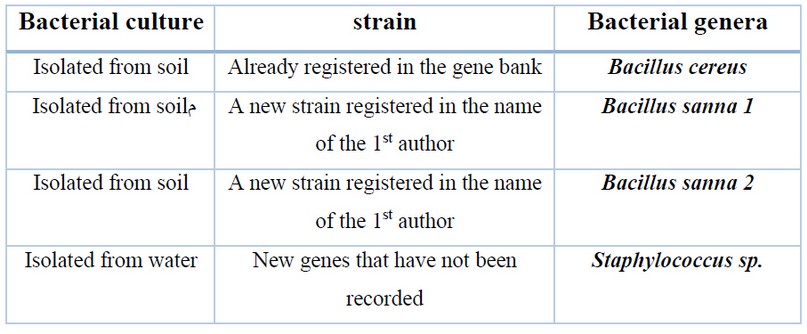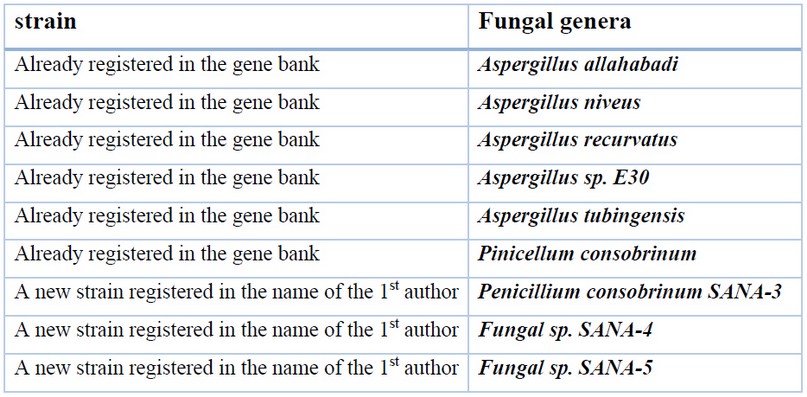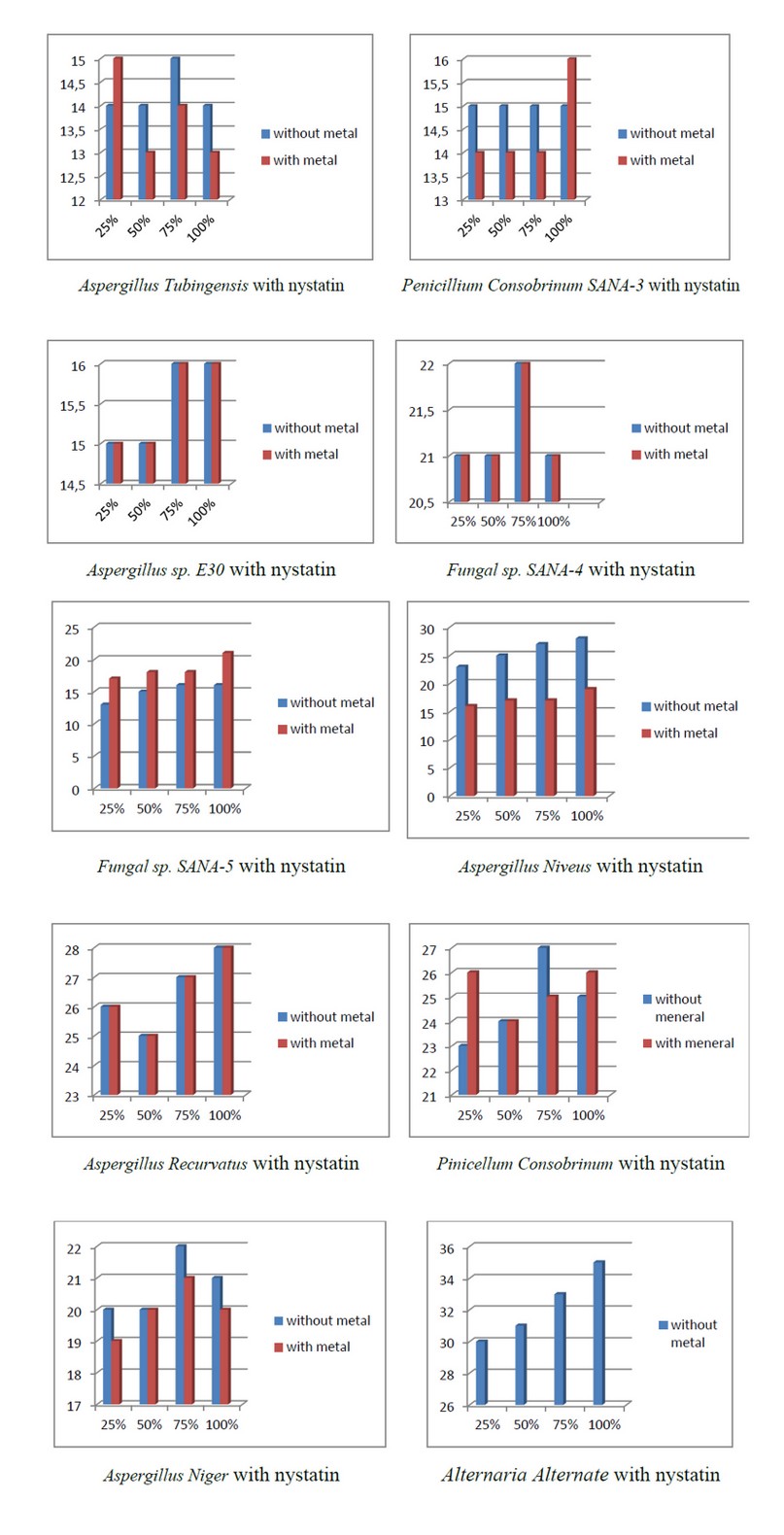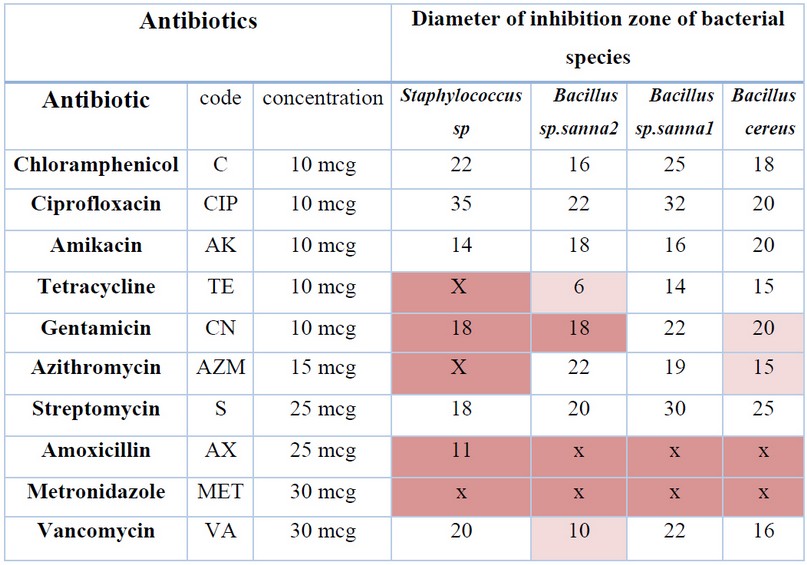2021.06.04.10
Files > Volume 6 > Vol 6 No 4 2021
INVESTIGATION / RESEARCH
Isolation and molecular identification of microorganisms isolated from soils contaminated with heavy metals in Mosul city
Sana R. Alkazaz1, Mohammad I. Khalil 1, Mazin N. Fadhel1
Available from: http://dx.doi.org/10.21931/RB/2021.06.04.10
ABSTRACT
This research is concerned with organisms isolated from soils contaminated with heavy metals in industrial and residential areas in Mosul, the center of Nineveh Governorate, and the diagnosis of these organisms using molecular biology techniques. Samples were collected from four locations in the city between the industrial area and residential neighborhoods.
Soil samples were analyzed, and dilutions were prepared, then the dilutions were grown on potato extract and dextrose (PDA) medium for the development of fungi and Nutrient agar for bacterial development. The dilutions were planted by the casting method by three replications, then the process of purifying the fungal and bacterial colonies was carried out using the traditional methods. To diagnose these pure colonies using PCR technique, colonies of fungi were grown on the medium of PDA, and bacteria were grown on the medium of nutritious broth.
As a result, nine fungal species were diagnosed; two of them are new undiagnosed genera that have been registered in the gene bank, four of them contain genetic mutations, and three of them are known and previously diagnosed fungi. As for bacteria, two new strains were isolated and registered in the gene bank among the four diagnosed types. And some of these genera exhibited severe resistance to antibiotics, while others showed moderate resistance, in contrast to the control, which was very sensitive to antibiotics.
Keywords: microorganisms, soils, contaminated, heavy metals
INTRODUCTION
A "heavy metal" is an element with metallic properties (such as luster, electrical and thermal conductivity), and a relatively high density. Although essential heavy metals are required in many biological processes such as growth and function at low concentrations, they are harmful if they exceed the required concentration 1,2.
High concentrations of toxic metals in soils are a serious environmental problem worldwide, posing significant risks to human health through various exposure pathways. Oral ingestion, inhalation of volatile and particulate matter, and dermal contact are the most critical human exposure pathways to metal-contaminated urban soils. Children are more likely to be exposed to toxic metals in urban soils than adults because they may absorb through the skin, ingest or inhale large amounts of toxic metals during outdoor activities and play 3. The most toxic heavy metals to plants such as lead (Pb), arsenic(As). Cadmium (Cd) and mercury (Hg) are metals found in the soil, which are highly mobile and are immediately absorbed by plants. Also, copper (Cu), chromium (Cr), zinc (Zn), selenium (Se), molybdenum (Mo), tin (Sn), and nickel (Ni) cause environmental pollution and health risks4. In his study, Rahman (2020) stated that pollution with heavy metals produced adverse effects such as mutagenic, teratogenic, and carcinogenic in humans and wildlife5.
Metal resistance is defined as the ability of an organism to survive and counteract metal toxicity by various mechanisms produced an indirect response to the metal species involved 6,7 or that this resistance is due to changes to the genetic material through mutations or the addition of new genetic material 8.
The term "antibiotics" was used for the first time in 1942 by the scientist Waksman, who defined antibiotics as metabolic substances produced by microorganisms that inhibit the growth of other microorganisms and do not affect the bacteria that produce them. Antibiotics target specific bacterial structures or processes and may act by inhibiting growth, directly killing the organism, or combining both mechanisms 9-12.
Most heavy metals are non-degradable and persist in the environment, and many species have evolved resistance mechanisms to combat metal toxicity. Heavy metals can cause selective pressure on microbial populations, leading to antimicrobial resistance through a "co- selection" mechanism 13,14.
This study aims to analyze soil samples contaminated with heavy metals to isolate and identify microorganisms (bacteria and fungi) thriving in this environment and investigate the sensitivity of isolated microorganisms to antibacterial and antifungal agents.
METHODS
Sample collection sites
Samples were collected from four areas: the first and second from near a local electricity generator inside a residential area and within an industrial area, the third and fourth samples from near car repair and maintenance shops in a residential area and industrial area in the city, as shown in Figure (1). The sample collection process was carried out using a sterile drilling tool and sterile sample collection bags with a depth of (0-15) cm.

Figure 1. Isolation and identification of organisms from soil
Isolation
The dilution method was used to isolate the organisms from the soil by taking 10 g of soil sample, placing it in a sterile glass beaker containing 90 ml of sterile distilled water, and shaking it well to obtain a dilution (10-3). The dishes were incubated upside down at 28 °C for 7 days for PDA medium and 37 °C for one day for nutrient agar (NA) medium. Then the colonies were purified by repeated transfer on the culture media, and the purified cultures were kept on a slant, kept in the refrigerator, renewed every month, and used when needed 15.
Diagnosis
Fungal and bacterial species isolated from soil samples were characterized by Polymerase Chain Reaction (PCR) by amplifying the Internal transcribed spacer (ITS) region preserved in the fungal DNA 16,17.
Study of Heavy metals Effect on the growth of living organisms (bacteria and fungi)
Two minerals were selected for the study, namely lead and zinc, the development of microorganisms on different concentrations of these minerals, and observation of the changes in them and their resistance to these concentrations. Fungi were cultured in PDA medium containing heavy metal separately at concentrations of (25, 50, 100, 150, 200 , 300, 400, 500, 600, 700, 800, 900, 1000) ppm and incubated for 7 days. The fungus with the highest growth on the metal was taken and grown with different concentrations of the antifungal (nystatin) and compared with the fungus grown without metal as a control. Bacteria were cultured in nutrient broth and incubated for one day, then cultured on a petri dish containing NA by wiping the plate with a cotton swap on each plate, then drilling in the culture medium to apply the concentrations of minerals In it, using a micropipette with a volume of 100 μl, and incubated for one day.
Cultivation of living organisms with Antibiotics
A spore suspension of mushrooms was made and distributed on the plate containing the medium of the PDA, then digging was made, and the antifungal (nystatin) was placed in it at concentrations of (25%, 50%, 75%, 100%), and the dish was incubated in the fungi incubator for seven days. As for the bacteria, the plate containing the agar-nutrient medium was wiped with bacteria grown on the broth fed with cotton, then antibiotic tablets were distributed on the surface of the medium and incubated in the bacteria incubator for one day 18,19.
RESULTS AND DISCUSSION
The current study results of the organisms isolated from the soil showed the genera shown in Tables (1 and 2).

Table 1. Isolated bacterial genera

Table 2. Isolated fungal genera
Study of resistance of microorganisms to heavy metals
Even though the importance of mineral elements to organisms for growth and function, such as potassium and magnesium and some trace elements such as manganese, iron, copper, zinc, and molypodium, some high concentrations of some are toxic harmful 1,20. , zinc and lead were chosen based on previous research on heavy metals in Mosul, the most recent of which was a study 21. Low concentrations of the mineral, as shown in pink in Tables (3 and 4), through an increase in the diameter of the colony and an increase in its number, then the growth gradually decreased until the death of the organism. This is consistent with the study, which indicates that minerals at low concentrations are nutritious to the organism, but their toxicity appears by increasing these concentrations 20,22. Some species were slightly inhibited but remained resistant even at a concentration of 1000 ppm of metal, and this is in line with what was stated 11 where organisms can acquire resistance as a result of the presence of some metals in high concentrations of more than a few thousand mg/kg (ppm).
Fungi are highly resistant compared to many other microorganisms due to their high tolerance to high temperatures and acidity, low nutrients, and high levels of minerals. However, this adaptation and resistance are demonstrated by changing the abundance and structure of the fungal community, and this appeared in our study in a change in the color and density of hyphae and colonies for many species 23-25. These studies also indicated that the fungi of the type Aspergillus and Penicillium were more resistant to heavy metals than the rest of the species, in addition to their ability to absorb some metals such as cadmium, lead biologically, and nickel, and their positive correlation with low levels of zinc and lead contamination, which is consistent with the results of the current study.
Heavy metals in trace amounts are necessary for the growth of bacteria, but they can be stress factors affecting the synthesis of proteins in them 23. Bacteria were cultured with different concentrations of heavy metals starting from 25 to 2000 ppm. The three bacterial species isolated from contaminated soil, in addition to bacteria isolated from the contaminated aquatic environment, were sensitive to zinc at small concentrations, starting from a concentration of 100 ppm, as shown in Tables (3 and 4), In contrast, to lead, which had a positive effect on it at low concentrations of the metal, which is consistent with most studies. However, it showed a negative effect starting from a concentration of 1400 ppm for three races. The fourth race remained resistant to the rise in metal concentration, and this may be a result in response to toxic metal stress and developing some survival mechanisms in their genome, such as producing a variety of enzymes and proteins that help them overcome this stress, as explained in his study 26.
In general, the bacterial species did not show strong resistance to metals. This may be because all bacterial species in this study are Gram-positive bacteria, and unlike Gram-negative bacteria, as stated in study 27, they tend to produce higher resistance levels. Compared to valued positive bacteria.

Table 3. The diameter of the inhibition in millimeters when cultivating bacteria with zinc metal in the form of zinc sulfate

Table 4. The diameter of the inhibition in millimeters when cultivating bacteria with lead metal in the form of lead (II) nitrate Pb(NO3)2
Cultivation of microorganisms with antibiotics
As shown in Figure (2), the current study results showed that the species Aspergillus tubingensis, Penicillium consobrinum SANA-3, Aspergillus sp E30 were almost identical moderately resistant during Fungal sp. SANA-5 was resistant without metal and in all antifungal concentrations, while it was sensitive to metal presence. Its explanation maybe what was stated in a study where heavy metals have adverse effects on the growth of microbes. Soil and fungi, the inhibition of fungal growth, come from heavy metals in the fungal cells 28.
Alternaria alternate isolate from a non-contaminated environment (as a control) was cultured with antifungal. The results showed that the fungus was more susceptible to the antifungal than the fungi isolated from the contaminated environment. This is consistent with what was stated in a previous study which reported that isolates from contaminated soil are more resistant than isolates from unpolluted environments 22.

Figure 2. Diameter of inhibition when cultivating fungal species with antifungal.
Concerning culturing bacteria with antibiotic tablets, the results showed resistance of all strains to amoxicillin and metronidazole, and Streptococcus bacteria resistant to tetracycline, gentamycin, and azithromycin as well. As shown in Table (5) and by comparing the damping diameter with the unique tables in some sources 18,19,29.
Streptococcus bacteria, which had the highest resistance among the bacterial genera under investigation, is a bacterium isolated from contaminated water. This resistance is explained by Dweba et al. (2018) in that these bacteria are characterized by their ability to develop antimicrobial resistance 30 rapidly. This resistance may Also be that heavy metals' biological availability in water is more than their biological availability in soil. It was mentioned in a study that soil and its quality impact the biological availability of minerals and the presence of linking elements as well as bacterial and biological groups and the concentration of organic gases such as methane and ethane and the formation of complexes 31.

Table 5. Diameter of inhibition in mm of antibiotic tablets with bacteria. The dark orange color indicates the resistance of bacteria to the antibiotic, while the light pink color indicates medium resistance, and the white color indicates that the bacteria are sensitive to these antibiotics
The multiple antibiotic resistance (MAR) index was adopted to determine the severity of bacterial resistance to antibiotics, which came in the study 12,32. whereas
MAR = the number of antibiotics that the isolate showed resistance to / the number of total antibiotics exposed.
It is interpreted as
MAR ≥ 0.2 as increased risk of antibiotic contamination.
MAR < 0.2 Low risk.
The results of the isolates were between (0.5-0.2), which indicates a high risk of antibiotic contamination, and that all these strains originated from a high-risk source of contamination.
CONCLUSION
Heavy metals, a large part of them, are naturally present, but they are toxic only if they are soluble in water and bioavailable, and this comes as a result of human activities most of the time. In addition to the results of previous studies, the current results show an overlap between heavy metal contamination and its resistance by microorganisms and the resistance of this organism to antibiotics, as heavy metals are an essential factor in making organisms resistant to antibiotics. The outcomes of this study will significantly contribute to the current body of knowledge of research towards public and veterinary health, especially in developing countries, and highlight the importance of fulfilling one-health attitudes to lower the ongoing spread of antimicrobial resistance.
REFERENCES
1. Hughes MN, Poole RK. Metal speciation and microbial growth—the hard (and soft) facts. Microbiology. 1991 1 April;137(4):725-34.
2. Bazzi W, Abou Fayad AG, Nasser A, Haraoui LP, Dewachi O, Abou-Sitta G, Nguyen VK, Abara A, Karah N, Landecker H, Knapp C. Heavy metal toxicity in armed conflicts potentiates AMR in A. baumannii by selecting for antibiotic and heavy metal co-resistance mechanisms. Frontiers in microbiology. 2020 3 February;11:68.
3. Karim Z, Qureshi BA. Health risk assessment of heavy metals in urban soil of Karachi, Pakistan. Human and ecological risk assessment: an international journal. 2014 4 May;20(3):658-67.
4. Dhalaria R, Kumar D, Kumar H, Nepovimova E, Kuča K, Torequl Islam M, Verma R. Arbuscular mycorrhizal fungi as potential agents in ameliorating heavy metal stress in plants. Agronomy. 2020 Jun;10(6):815.
5. Rahman, Z. (2020) 'An overview on heavy metal resistant microorganisms for simultaneous treatment of multiple chemical pollutants at co-contaminated sites, and their multipurpose application', Journal of Hazardous Materials, 396(February), p. 122682. doi: 10.1016/j.jhazmat.2020.122682.
6. . Mehra RK, Winge DR. Metal ion resistance in fungi: molecular mechanisms and their regulated expression. Journal of cellular biochemistry. 1991 Jan;45(1):30-40.
7. Prasenjit B, Sumathi S. Uptake of chromium by Aspergillus foetidus. Journal of Material Cycles and Waste Management. 2005 Aug 1;7(2):88-92.
8. Bennett PM. Plasmid encoded antibiotic resistance: acquisition and transfer of antibiotic resistance genes in bacteria. British journal of pharmacology. 2008 Mar;153(S1):S347-57.
9. Manad, Ahmed (2007), Effect of mercury pollution on the spread of soil fungi in Azaba region, PhD thesis, Faculty of Science, Mentouri University of Constantine.
10. Aminov RI, Mackie RI. Evolution and ecology of antibiotic resistance genes. FEMS microbiology letters. 2007 1 June;271(2):147-61.
11. Pal, C. et al. (2017) Metal Resistance and Its Association With Antibiotic Resistance. 1st edn, Advances in Microbial Physiology. 1st edn. Elsevier Ltd. doi: 10.1016/bs.ampbs.2017.02.001.
12. Dweba CC, Zishiri OT, El Zowalaty ME. Isolation and molecular identification of virulence, antimicrobial and heavy metal resistance genes in livestock-associated methicillin-resistant Staphylococcus aureus. Pathogens. 2019 Jun;8(2):79.
13. Li LG, Xia Y, Zhang T. Co-occurrence of antibiotic and metal resistance genes revealed in complete genome collection. The ISME journal. 2017 Mar;11(3):651-62
14. Seiler C, Berendonk TU. Heavy metal driven co-selection of antibiotic resistance in soil and water bodies impacted by agriculture and aquaculture. Frontiers in microbiology. 2012 14 December;3:399.
15. Meysami P, Baheri H. Pre-screening of fungi and bulking agents for contaminated soil bioremediation. Advances in Environmental Research. 2003 1 June;7(4):881-7.
16. Abdullah, O. Abdul-Jabbar (2020), Fungal bioremediation of polycyclic aromatic hydrocarbons in soils contaminated with crude oil, Master's thesis, College of Environmental Sciences and Technologies, University of Mosul.
17. Altaee, M. I. Khalil (2018), Molecular Biology, Evidence for Polymerase Chain Reaction (PCR), Azariat Al-Kitab and Graduate Studies House - Alexandria.
18. Bhalodia, N. R., Nariya, P. B. and Shukla, V. J. (2011) 'Antibacterial and antifungal activity from flower extracts of Cassia fistula L.: An ethnomedicinal plant', International Journal of PharmTech Research, 3(1), pp. 160–168. doi: 10.4103/2231-4040.82956.
19. Tokarzewski S, Ziólkowska G, Nowakiewicz A. Susceptibility testing of Aspergillus niger strains isolated from poultry to antifungal drugs-a comparative study of the disk diffusion, broth microdilution (M 38-A) and Etest methods. Polish journal of veterinary sciences. 2012;15(1).
20. Osredkar J, Sustar N. Copper and zinc, biological role and significance of copper/zinc imbalance. J Clinic Toxicol S. 2011;3(2161):0495.
21 Znad, S. R. and Al-Sinjary, M. N. (2020) 'Assessment of heavy metal pollution of industrial zones in mosul city', Plant Archives, 20(August), pp. 256–263.
22. Raftos, D. and Radford, J. (2015) 'BIOACCUMULATION OF HEAVY METALS BY FUNGI', INTERNATIONAL JOURNAL OF ENVIRONMENTAL CHEMISTRY & CHROMATOGRAPHY, 14(2), pp. 40–43.
23. Zhou Y, Xu YB, Xu JX, Zhang XH, Xu SH, Du QP. Combined toxic effects of heavy metals and antibiotics on a Pseudomonas fluorescens strain ZY2 isolated from swine wastewater. International Journal of molecular sciences. 2015 Feb;16(2):2839-50.
24. Qasim S, Fadhel MN, Khalil MI. Isolation and molecular identification of microorganisms isolated from soils contaminated with heavy metals in Mosul city.
25. Lin Y, Xiao W, Ye Y, Wu C, Hu Y, Shi H. Adaptation of soil fungi to heavy metal contamination in paddy fields—a case study in eastern China. Environmental Science & Pollution Research. 2020 1 August;27(22).
26. Das S, Dash HR, Chakraborty J. Genetic basis and importance of metal resistant genes in bacteria for bioremediation of contaminated environments with toxic metal pollutants. Applied microbiology and biotechnology. 2016 1 April;100(7):2967-84.
27. Nguyen CC, Hugie CN, Kile ML, Navab-Daneshmand T. Association between heavy metals and antibiotic-resistant human pathogens in environmental reservoirs: a review. Frontiers of Environmental Science & Engineering. 2019 Jun;13(3):1-7.
28. Morkunas I, Woźniak A, Mai VC, Rucińska-Sobkowiak R, Jeandet P. The role of heavy metals in plant response to biotic stress. Molecules. 2018 Sep;23(9):2320
29. Aditi FY, Rahman SS, Hossain MM. A study on the microbiological status of mineral drinking water. The open microbiology journal. 2017;11:31.
30. Dweba CC, Zishiri OT, El Zowalaty ME. Methicillin-resistant Staphylococcus aureus: livestock-associated, antimicrobial, and heavy metal resistance. Infection and Drug Resistance. 2018;11:2497.
31. Glibota N, Grande M, Galvez A, Ortega E. Genetic Determinants for Metal Tolerance and Antimicrobial Resistance Detected in Bacteria Isolated from Soils of Olive Tree Farms. Antibiotics. 2020 Aug;9(8):476.
32. Mandal S, Das S, Mandal M. Plasmid mediated antibiotic and heavy metal co-resistance in bacterial isolates from Mahananda river water (Malda, India). J Transl Med. 2016;6(185):2161-1025.
Received: 9 July 2021
Accepted 14 august 2021
Sana R. Alkazaz1, Mohammad I. Khalil 1, Mazin N. Fadhel1
1 College of Environmental Sciences, University of Mosul, Mosul, Iraq, 41001.
https://orcid.org/0000-0002-1624-0717
